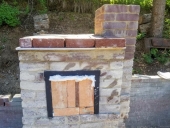




 . I would imagine it has clay sand and fire cement but the proportions is what I need any and all help will be grateful TIA David
. I would imagine it has clay sand and fire cement but the proportions is what I need any and all help will be grateful TIA David
If we lose freedom here, there is no place to escape to.
This is the last stand on earth.
R.R. 1964




Success has a Thousand Fathers , Failure is an Orphan
LOOK AT THE " SIMILAR THREADS " BELOW !

 1
1




For all your Montana Masonry Heater parts (also known as) Rocket Mass heater parts.
Visit me at
dragontechrmh.com Once you go brick you will never go back!




www.dragonheaters.com
http://blog.dragonheaters.com/










Success has a Thousand Fathers , Failure is an Orphan
LOOK AT THE " SIMILAR THREADS " BELOW !




thomas rubino wrote:David; ; Components of cast cores & risers are one 50#sack fireclay + one 2 cubic foot bag perlite + fiberglass as a binder and as much refractory cement as you can afford , I used 2 gal tub between core & riser. I would have 4 bags of fireclay on hand and 2 four foot bags of perlite, I used bagged concrete fiberglass as my binder maybe 1/2 bag for core less for the riser. I used an 8" sonitube as my inner form on the riser with a 16 gal metal barrel as the outer form. The core is formed with plywood & hardy board. When i build my next cast core & riser I will also have a bottle of sodium silicate (waterglass) on hand and paint all fire surfaces inside the core & the top of the riser just before firing to create a harder refractory surface.










Success has a Thousand Fathers , Failure is an Orphan
LOOK AT THE " SIMILAR THREADS " BELOW !

|
It's just a flesh wound! Or a tiny ad:
Learn Permaculture through a little hard work
https://wheaton-labs.com/bootcamp
|


